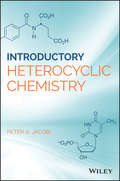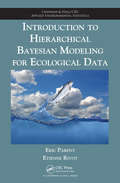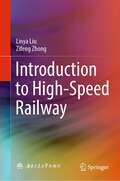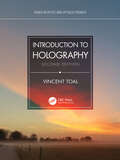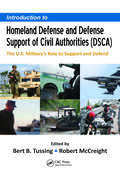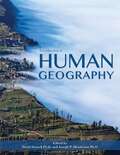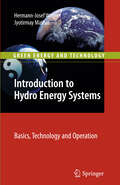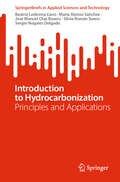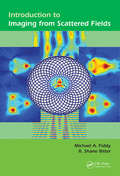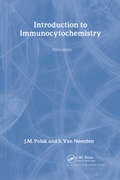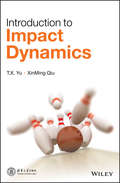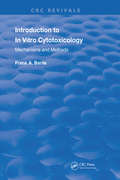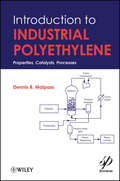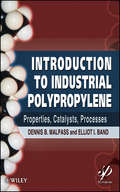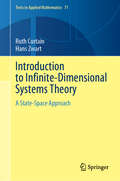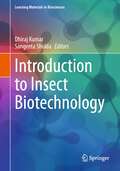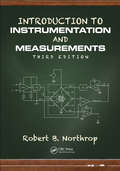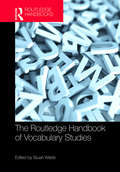- Table View
- List View
Introduction to Health Research Methods: A Practical Guide
by Kathryn H. JacobsenDesigned to empower new investigators to conduct their own original research projects, the third edition of Introduction to Health Research Methods: A Practical Guide leads the reader step-by-step in performing quantitative and qualitative research in medicine, public health, and other clinical and population health fields. Organized in five sections, the text covers the entire research process from formulating a study question and selecting a study approach to collecting and analyzing data and then disseminating the findings. Chapters about methods for primary studies (collecting new data), secondary analyses (analyzing existing data), and tertiary studies (conducting literature reviews and meta-analyses) provide comprehensive coverage of the scope of health research. By breaking the research process down into a series of achievable steps, Introduction to Health Research Methods shows students and early career scholars how they can contribute to improving the health of individuals and communities through research. The Third Edition has been significantly updated to include: - Expanded coverage of qualitative research methods, including new chapters on qualitative study design, data collection, and data analysis. - Additional glossary terms that clarify key terminology for all stages of the research process and a diversity of study approaches. - Enhanced explanations of how to select and implement quantitative and qualitative research and analysis methodologies. - New and updated coverage of topics such as framing research questions, developing testable hypotheses, defining specific aims, responsibly conducting research, selecting study designs, minimizing bias, applying theoretical paradigms, ensuring rigor and reproducibility, conducting quality assessment, managing grants, and more.
Introduction to Heterocyclic Chemistry
by Peter A. JacobiA unique approach to a core topic in organic chemistry presented by an experienced teacher to students and professionals Heterocyclic rings are present in the majority of known natural products, contributing to enormous structural diversity. In addition, they often possess significant biological activity. Medicinal chemists have embraced this last property in designing most of the small molecule drugs in use today. This book offers readers a fundamental understanding of the basics of heterocyclic chemistry and their occurrence in natural products such as amino acids, DNA, vitamins, and antibiotics. Based on class lectures that the author has developed over more than 40 years of teaching, it focuses on the chemistry of such heterocyclic substances and how they differ from carbocyclic systems. Introductory Heterocyclic Chemistry offers in-depth chapters covering naturally occurring heterocycles; properties of aromatic heterocycles; π-deficient heterocycles; π-excessive heterocycles; and ring transformations of heterocycles. It then offers an overview of 1,3-dipolar cycloadditions before finishing up with a back-to-basics section on nitriles and amidines. Presents a conversational approach to a fundamental topic in organic chemistry teaching Offers a unique look at this core organic chemistry topic via important naturally occurring and/or biologically active heterocycles Based on the author's many years of class lectures for teaching at the undergraduate and graduate level as well as pharmaceutical-industry courses Clear, concise, and accessible for advanced students of chemistry to gain a fundamental understanding of the basics of heterocyclic chemistry Introductory Heterocyclic Chemistry is an excellent text for undergraduate and graduate students as well as chemists in industrial environments in chemistry, pharmacy, medicinal chemistry, and biology.
Introduction to Hierarchical Bayesian Modeling for Ecological Data (Chapman & Hall/CRC Applied Environmental Statistics)
by Eric Parent Etienne RivotMaking statistical modeling and inference more accessible to ecologists and related scientists, Introduction to Hierarchical Bayesian Modeling for Ecological Data gives readers a flexible and effective framework to learn about complex ecological processes from various sources of data. It also helps readers get started on building their own statisti
Introduction to High Energy Physics
by Donald H. PerkinsThis highly regarded textbook for advanced undergraduates provides a comprehensive introduction to modern particle physics. Coverage emphasizes the balance between experiment and theory. It places stress on the phenomenological approach and basic theoretical concepts rather than rigorous mathematical detail. Donald Perkins also details recent developments in elementary particle physics, as well as its connections with cosmology and astrophysics. A number of key experiments are also identified along with a description of how they have influenced the field. Perkins presents most of the material in the context of the Standard Model of quarks and leptons. He also fully explores the shortcomings of this model and new physics beyond its compass (such as supersymmetry, neutrino mass and oscillations, GUTs and superstrings). The text includes many problems and a detailed and annotated further reading list. The volume will also provide a solid foundation for graduate study.
Introduction to High-Speed Railway
by Linya Liu Zifeng ZhongThis book provides a comprehensive overview of various aspects of high-speed railways, such as infrastructure, communication signals, traction power supply, trainsets, and transportation organization. It delves into the basic concepts, fundamental theories, and the latest technological achievements in these areas, equipping readers with a strong foundation in the subject matter. The content is organized into eight chapters: Introduction, High-Speed Railway Lines and Infrastructure, Power Supply Systems, High-Speed Railway Trainsets, Signal and Communication Systems, Transportation Organization, Passenger Services, and Maglev Railways. Each chapter explores different facets of high-speed railway systems, focusing on the unique characteristics, design principles, and operational methodologies that set them apart from traditional railway systems. The book also highlights recent breakthroughs and innovations in the field, giving readers a glimpse of the future potential of high-speed railways. The book is tailored to meet the needs of undergraduate and graduate students pursuing degrees in railway transportation, railway engineering, locomotive vehicles, electrical traction, signal communication, and related fields. It offers a systematic and in-depth understanding of high-speed railway systems, enabling students to grasp the subject matter and apply their knowledge to real-world situations. It can also be a training material for railway professionals looking to expand their knowledge and skills in high-speed railway systems. Furthermore, the book can be a useful reference for postgraduate students engaged in research in relevant fields. It offers a wealth of information and insights, assisting researchers in understanding the intricacies of high-speed railway systems, and exploring new avenues for innovation and improvement.
Introduction to Holography (Series in Optics and Optoelectronics)
by Vincent ToalThis fully updated second edition of Introduction to Holography provides a theoretical background in optics and holography with a comprehensive survey of practical applications. It is intended for the non-specialist with an interest in using holographic methods in research and engineering. The text assumes some knowledge of electromagnetism, although this is not essential for an understanding of optics, which is covered in the first two chapters. A descriptive approach to the history and principles of holography is followed by a chapter on volume holography. Essential practical requirements for successful holographic recording are explained in detail. Recording materials are considered with detailed discussions of those in common use. Properties peculiar to holographically reconstructed images are emphasised as well as applications for which holography is particularly suitable. Mathematical tools are introduced as and when required throughout the text with important results derived in detail. In this new edition, topics such as photopolymers, dynamic holographic displays, holographic optical elements, sensors, and digital holography are covered in greater depth. New topics have been added, including UV and infrared holography, holographic authentication and encryption, as well as particle beam, X-ray, and acoustic holography. Numerical problems are provided at the end of each chapter. This book is suitable for undergraduate courses and will be an important resource for those teaching optics and holography. It provides scientists and engineers with knowledge of a wide range of holographic applications in research and industry, as well as an understanding of holography’s potential for future use.
Introduction to Homeland Defense and Defense Support of Civil Authorities (DSCA): The U.S. Military's Role to Support and Defend
by Bert B. Tussing Robert McCreightThe application of our Armed Forces within the states and territories of the United States is far from intuitive. The challenges of defending the country against assaults within the homeland are much more complex than engaging our enemies on foreign soil. Likewise, the introduction of the military‘s appreciable capabilities in response to disasters
Introduction to Horticultural Science (Second Edition)
by Richard N. ArtecaDesigned to provide readers with a full appreciation of the wonderful world of horticultural science, the Second Edition of INTRODUCTION TO HORTICULTURAL SCIENCE covers everything the reader needs to know in a comprehensive format that is easy to understand. Coverage includes critical topics such as fundamental concepts, cutting edge research, careers in horticulture, the relationship between horticulture and the environment, classification of plants, and plant anatomy. Readers are also introduced to key concepts such as plant propagation, media, nutrients and fertilizers, plants and the environment, plant growth regulators, post harvest physiology and pest management, greenhouse structures, nursery site selection, development and facilities, producing nursery crops, and floral design. Through enhanced visual aids and the inclusion of recent trends in the field, the second edition has been designed to peak reader interest and improve reader understanding.
Introduction to Horticulture, Revised 4th Edition
by Charles B. Schroeder Eddie Dean Seagle Gerard Krewer John M. Ruter Lorie M. Felton William Terry Kelley Jasper S. LeeThis basic text with larger than usual type, simple language, and essentially traditional content offers beginning horticultural students an overview of the field, scientific basics, greenhouse management and production, nursery management and production, floriculture products, landscaping, turfgrass, food crops, and tools and technology. The editors cite such improvements in this updated edition (previous edition: 1997) as more photographs, increased technological applications, greater emphasis on environmentally-friendly approaches, some rewritten sections, and a new chapter on horticultural business management. Annotation c. Book News, Inc. , Portland, OR (booknews. com)
Introduction to Human Geography
by David Dorrell Joseph P. HendersonGeography is a diverse discipline that has some sort of connection to most every other academic discipline. This connection is the spatial perspective, which essentially means if a phenomenon can be mapped, it has some kind of relationship to geography. Studying the entire world is a fascinating subject, and geographical knowledge is fundamental to a competent understanding of our world. You will learn what geography is as well as some of the fundamental concepts that underpin the discipline. These fundamental terms and concepts will be interwoven throughout the text, so a sound understanding of these topics is critical as you delve deeper into the chapters that follow. By the end of the first chapter itself, you will begin to think like a geographer.
Introduction to Hydro Energy Systems: Basics, Technology and Operation
by Hermann-Josef Wagner Jyotirmay MathurThe authors have tried to strike a balance between a short book chapter and a very detailed book for subject experts. There are three prime reasons behind for doing so: first, the field is quite interdisciplinary and requires simplified presentation for a person from non-parent discipline. The second reason for this short-version of a full book is that both the authors have seen students and technically oriented people, who were searching for this type of book on hydro energy. The third reason and motivation was considering engineers who are starting their career in hydro energy sector. This book is targeted to present a good starting background and basic understanding for such professionals.
Introduction to Hydrocarbonization: Principles and Applications (SpringerBriefs in Applied Sciences and Technology)
by Sergio Nogales Delgado Beatriz Ledesma Cano María Alonso Sánchez José Manuel Díaz Rasero Silvia Román SueroThe book is a comprehensive exploration of hydrothermal carbonization (HTC), addressing key aspects from its definition and historical relevance to its practical applications and environmental considerations. Throughout its sections, the reader will gain an understanding of the fundamental principles of HTC, including the chemical reactions involved and the catalysts used. In addition, the book provides a comprehensive overview of the various types of waste that can be utilized in the process, from organic sources to industrial and municipal solid wastes. Highlighting the importance in various industries and research areas, case studies illustrating successful applications are presented. A practical perspective is also provided, including exercises for students, exploring laboratory techniques and experiments related to hydrocarbonization. In addition, its focus on research and innovation, addressing current trends and emerging technologies, positions this book as a valuable source for students, researchers, and professionals interested in exploring and developing this field with an emphasis on its potential impact on energy, the environment, and sustainability. The conclusion provides a concise summary of key concepts, a discussion of the future of hydrocarbonization, and an encouragement for students to venture into research in this promising field.
Introduction to Hydrogen Technology
by K. S. Santhanam Roman J. Press Massoud J. Miri Alla V. Bailey Gerald A. TakacsIntroduces the field of hydrogen technology and explains the basic chemistry underlying promising and innovative new technologies This new and completely updated edition of Introduction to Hydrogen Technology explains, at an introductory level, the scientific and technical aspects of hydrogen technology. It incorporates information on the latest developments and the current research in the field, including: new techniques for isolating and storing hydrogen, usage as a fuel for automobiles, residential power systems, mobile power systems, and space applications. Introduction to Hydrogen Technology, Second Edition features classroom-tested exercises and sample problems. It details new economical methods for isolating the pure hydrogen molecule. These less expensive methods help make hydrogen fuel a very viable alternative to petroleum-based energy. The book also adds a new chapter on hydrogen production and batteries. It also provides in-depth coverage of the many technical hurdles in hydrogen storage. The developments in fuel cells since the last edition has been updated. Offers new chapters on hydrogen production, storage, and batteries Features new sections on advanced hydrogen systems, new membranes, greenhouse gas sensors and updated technologies involving solar and wind energies Includes problems at the end of the Chapters, as well as solutions for adopters This book is an introduction to hydrogen technology for students who have taken at least one course in general chemistry and calculus; it will also be a resource book for scientists and researchers working in hydrogen-based technologies, as well as anyone interested in sustainable energy.
Introduction to Imaging from Scattered Fields
by Michael A Fiddy R. Shane RitterObtain the Best Estimate of a Strongly Scattering Object from Limited Scattered Field DataIntroduction to Imaging from Scattered Fields presents an overview of the challenging problem of determining information about an object from measurements of the field scattered from that object. It covers widely used approaches to recover information about th
Introduction to Immunocytochemistry
by 0 J.M. Polak and S. Van Noorden Dame Julia Polak Susan Van NoordenThis book provides a practically directed basis for carrying out immunocytochemical methods with enough theoretical information to allow a newcomer to understand the whys and wherefores of the technique. It explains tissue preparation, cytological preparations and new methods of multiple staining.
Introduction to Impact Dynamics
by T. X. Yu Xinming QiuFundamental guidance—including concepts, models, and methodology—for better understanding the dynamic behavior of materials and for designing for objects and structures under impact or intensive dynamic loading This book introduces readers to the dynamic response of structures with important emphasis on the material behavior under dynamic loadings. It utilizes theoretical modelling and analytical methods in order to provide readers with insight into the various phenomena. The content of the book is an introduction to the fundamental aspects, which underpin many important industrial areas. These areas include the safety of various transportation systems and a range of different structures when subjected to various impact and dynamic loadings, including terrorist attacks. Presented in three parts—Stress Waves in Solids, Dynamic Behaviors of Materials Under High Strain Rate, and Dynamic Response of Structures to Impact and Pulse Loading—Introduction to Impact Dynamics covers elastic waves, rate dependent behaviors of materials, effects of tensile force, inertial effects, and more. The book also features numerous case studies to aid in facilitating learning. The strength of the book is its clarity, balanced coverage, and practical examples, which allow students to learn the overall knowledge of impact dynamics in a limited time whilst directing them to explore more advanced technical knowledge and skills. Considers both the dynamic behavior of materials and stress waves, and the dynamic structural response and energy absorption, emphasizing the interaction between material behavior and the structural response Provides a comprehensive description of the phenomenon of impact of structures, containing both fundamental issues of wave propagation and constitutive relation of materials, and the dynamic response of structures under impact loads Based on the authors’ research and teaching experience as well as updated developments in the field Introduction to Impact Dynamics is the perfect textbook for graduate and postgraduate students, and will work as a reference for engineers in the fields of solid mechanics, automotive design, aerospace, mechanical, nuclear, marine, and defense.
Introduction to In Vitro Cytotoxicology: Mechanisms and Methods (Routledge Revivals)
by Frank A. BarileFirst Published in 1994, Introduction to In Vitro Cytotoxicology examines in vitro cytotoxicology, which offers new methodologies to toxicity testing. This important new discipline of modern toxicology is gaining increased acceptance as a viable alternative to traditional testing methods. The text discusses the application of in vitro cytotoxicology to toxicity testing and human risk assessment, and it analyzes the advantages and limitations of the tests performed under scientific and regulatory conditions. The book also reviews the optimum utilization of certain tests for specific groups of chemicals relevant to validation programs currently in progress. This book is a useful reference tool for students, researchers, and practitioners interested in academic, industrial, and regulatory toxicology; environmental health; cell biology; pharmacology; dentistry; or human and veterinary medicine.
Introduction to Industrial Polyethylene: Properties, Catalysts, and Processes (Wiley-Scrivener #45)
by Dennis B. MalpassDemystifies the largest volume manmade synthetic polymer by distillingthe fundamentals of what polyethylene is, how it's made and processed,and what happens to it after its useful life is over. Endorsement for Introduction to Industrial Polyethylene "I found this to be a straightforward, easy-to-read, and useful introductory text on polyethylene, which will be helpful for chemists, engineers, and students who need to learn more about this complex topic. The author is a senior polyethylene specialist and I believe we can all benefit from his distillation of knowledge and insight to quickly grasp the key learnings." —R.E. King III; Ciba Corporation (part of the BASF group) Jargon used in industrial polyethylene technology can often be bewildering to newcomers. Introduction to Industrial Polyethylene educates readers on terminology commonly used in the industry and demystifies the chemistry of catalysts and cocatalysts employed in the manufacture of polyethylene. This concise primer reviews the history of polyethylene and introduces basic features and nomenclatures for this versatile polymer. Catalysts and cocatalysts crucial to the production of polyethylene are discussed in the first few chapters. Latter chapters provide an introduction to the processes used to manufacture polyethylene and discuss matters related to downstream applications of polyethylene such as rheology, additives, environmental issues, etc. Providing industrial chemists and engineers a valuable reference tool that covers fundamental features of polyethylene technology, Introduction to Industrial Polyethylene: Identifies the fundamental types of polyethylene and how they differ. Lists markets, key fabrication methods, and the major producers of polyethylene. Provides biodegradable alternatives to polyethylene. Describes the processes used in the manufacture of polyethylene. Includes a thorough glossary, providing definitions of acronyms and abbreviations and also defines terms commonly used in discussions of production and properties of polyethylene. Concludes with the future of industrial polyethylene.
Introduction to Industrial Polypropylene
by Dennis B. Malpass Elliot BandThis introductory text is an important resource for new engineers, chemists, students, and chemical industry personnel to understand the technical aspects of polypropylene which is the 2nd largest synthetics polymer in manufactured output. The book considers the following topics:What are the principal types of polypropylene and how do they differ? What catalysts are used to produce polypropylene and how do they function? What is the role of cocatalysts and how have they evolved over the years? How are industrial polypropylene catalysts tested and the resultant polymer evaluated? What processes are used in the manufacture of polypropylene? What are the biopolymer alternatives to polypropylene? What companies are the major industrial manufacturers of polypropylene? What is the environmental fate of polypropylene?
Introduction to Infinite-Dimensional Systems Theory: A State-Space Approach (Texts in Applied Mathematics #71)
by Hans Zwart Ruth CurtainInfinite-dimensional systems is a well established area of research with an ever increasing number of applications. Given this trend, there is a need for an introductory text treating system and control theory for this class of systems in detail. This textbook is suitable for courses focusing on the various aspects of infinite-dimensional state space theory. This book is made accessible for mathematicians and post-graduate engineers with a minimal background in infinite-dimensional system theory. To this end, all the system theoretic concepts introduced throughout the text are illustrated by the same types of examples, namely, diffusion equations, wave and beam equations, delay equations and the new class of platoon-type systems. Other commonly met distributed and delay systems can be found in the exercise sections. Every chapter ends with such a section, containing about 30 exercises testing the theoretical concepts as well. An extensive account of the mathematical background assumed is contained in the appendix.
Introduction to Infinite-Equilibriums in Dynamical Systems
by Albert C.J LuoThis book examines infinite-equilibriums for the switching bifurcations of two 1-dimensional flows in dynamical systems. Quadratic single-linear-bivariate systems are adopted to discuss infinite-equilibriums in dynamical systems. For such quadratic dynamical systems, there are three types of infinite-equilibriums. The inflection-source and sink infinite-equilibriums are for the switching bifurcations of two parabola flows on the two-directions. The parabola-source and sink infinite-equilibriums are for the switching bifurcations of parabola and inflection flows on the two-directions. The inflection upper and lower-saddle infinite-equilibriums are for the switching bifurcation of two inflection flows in two directions. The inflection flows are for appearing bifurcations of two parabola flows on the same direction. Such switching bifurcations for 1-dimensional flow are based on the infinite-equilibriums, which will help one understand global dynamics in nonlinear dynamical systems. This book introduces infinite-equilibrium concepts and such switching bifurcations to nonlinear dynamics.
Introduction to Insect Biotechnology (Learning Materials in Biosciences)
by Dhiraj Kumar Sangeeta ShuklaThis textbook introduces to the fundamentals and applications of insect biotechnology in a concise manner. Global economically important insects such as silkworm, lac or honey bee are in the focus of this text. The book attempts to address all of the latest developments in this growing field such as application of metagenomics and proteomics in mining for genes and enzymes that could be beneficial in diverse industrial and biomedical applications. Further, insects have been established as suitable tool for the production of transgenic products which is discussed in one dedicated chapter. The book targets students and researchers in molecular biology, biotechnology or entomology who want to get familiar with the emerging field of insect biotechnology.
Introduction to Instrumentation and Measurements
by Robert B. NorthropWeighing in on the growth of innovative technologies, the adoption of new standards, and the lack of educational development as it relates to current and emerging applications, the third edition of Introduction to Instrumentation and Measurements uses the authors’ 40 years of teaching experience to expound on the theory, science, and art of modern instrumentation and measurements (I&M). What’s New in This Edition: This edition includes material on modern integrated circuit (IC) and photonic sensors, micro-electro-mechanical (MEM) and nano-electro-mechanical (NEM) sensors, chemical and radiation sensors, signal conditioning, noise, data interfaces, and basic digital signal processing (DSP), and upgrades every chapter with the latest advancements. It contains new material on the designs of micro-electro-mechanical (MEMS) sensors, adds two new chapters on wireless instrumentation and microsensors, and incorporates extensive biomedical examples and problems. Containing 13 chapters, this third edition: Describes sensor dynamics, signal conditioning, and data display and storage Focuses on means of conditioning the analog outputs of various sensors Considers noise and coherent interference in measurements in depth Covers the traditional topics of DC null methods of measurement and AC null measurements Examines Wheatstone and Kelvin bridges and potentiometers Explores the major AC bridges used to measure inductance, Q, capacitance, and D Presents a survey of sensor mechanisms Includes a description and analysis of sensors based on the giant magnetoresistive effect (GMR) and the anisotropic magnetoresistive (AMR) effect Provides a detailed analysis of mechanical gyroscopes, clinometers, and accelerometers Contains the classic means of measuring electrical quantities Examines digital interfaces in measurement systems Defines digital signal conditioning in instrumentation Addresses solid-state chemical microsensors and wireless instrumentation Introduces mechanical microsensors (MEMS and NEMS) Details examples of the design of measurement systems Introduction to Instrumentation and Measurements is written with practicing engineers and scientists in mind, and is intended to be used in a classroom course or as a reference. It is assumed that the reader has taken core EE curriculum courses or their equivalents.
Introduction to Instrumentation and Measurements
by Robert B. NorthropWeighing in on the growth of innovative technologies, the adoption of new standards, and the lack of educational development as it relates to current and emerging applications, the third edition of Introduction to Instrumentation and Measurements uses the authors’ 40 years of teaching experience to expound on the theory, science, and art of modern instrumentation and measurements (I&M). What’s New in This Edition: This edition includes material on modern integrated circuit (IC) and photonic sensors, micro-electro-mechanical (MEM) and nano-electro-mechanical (NEM) sensors, chemical and radiation sensors, signal conditioning, noise, data interfaces, and basic digital signal processing (DSP), and upgrades every chapter with the latest advancements. It contains new material on the designs of micro-electro-mechanical (MEMS) sensors, adds two new chapters on wireless instrumentation and microsensors, and incorporates extensive biomedical examples and problems. Containing 13 chapters, this third edition: Describes sensor dynamics, signal conditioning, and data display and storage Focuses on means of conditioning the analog outputs of various sensors Considers noise and coherent interference in measurements in depth Covers the traditional topics of DC null methods of measurement and AC null measurements Examines Wheatstone and Kelvin bridges and potentiometers Explores the major AC bridges used to measure inductance, Q, capacitance, and D Presents a survey of sensor mechanisms Includes a description and analysis of sensors based on the giant magnetoresistive effect (GMR) and the anisotropic magnetoresistive (AMR) effect Provides a detailed analysis of mechanical gyroscopes, clinometers, and accelerometers Contains the classic means of measuring electrical quantities Examines digital interfaces in measurement systems Defines digital signal conditioning in instrumentation Addresses solid-state chemical microsensors and wireless instrumentation Introduces mechanical microsensors (MEMS and NEMS) Details examples of the design of measurement systems Introduction to Instrumentation and Measurements is written with practicing engineers and scientists in mind, and is intended to be used in a classroom course or as a reference. It is assumed that the reader has taken core EE curriculum courses or their equivalents.
Introduction to Instrumentation and Measurements (Studies In Mathematical Thinking And Learning Ser.)
by Robert B. NorthropWeighing in on the growth of innovative technologies, the adoption of new standards, and the lack of educational development as it relates to current and emerging applications, the third edition of Introduction to Instrumentation and Measurements uses the authors’ 40 years of teaching experience to expound on the theory, science, and art of modern instrumentation and measurements (I&M). What’s New in This Edition: This edition includes material on modern integrated circuit (IC) and photonic sensors, micro-electro-mechanical (MEM) and nano-electro-mechanical (NEM) sensors, chemical and radiation sensors, signal conditioning, noise, data interfaces, and basic digital signal processing (DSP), and upgrades every chapter with the latest advancements. It contains new material on the designs of micro-electro-mechanical (MEMS) sensors, adds two new chapters on wireless instrumentation and microsensors, and incorporates extensive biomedical examples and problems. Containing 13 chapters, this third edition: Describes sensor dynamics, signal conditioning, and data display and storage Focuses on means of conditioning the analog outputs of various sensors Considers noise and coherent interference in measurements in depth Covers the traditional topics of DC null methods of measurement and AC null measurements Examines Wheatstone and Kelvin bridges and potentiometers Explores the major AC bridges used to measure inductance, Q, capacitance, and D Presents a survey of sensor mechanisms Includes a description and analysis of sensors based on the giant magnetoresistive effect (GMR) and the anisotropic magnetoresistive (AMR) effect Provides a detailed analysis of mechanical gyroscopes, clinometers, and accelerometers Contains the classic means of measuring electrical quantities Examines digital interfaces in measurement systems Defines digital signal conditioning in instrumentation Addresses solid-state chemical microsensors and wireless instrumentation Introduces mechanical microsensors (MEMS and NEMS) Details examples of the design of measurement systems Introduction to Instrumentation and Measurements is written with practicing engineers and scientists in mind, and is intended to be used in a classroom course or as a reference. It is assumed that the reader has taken core EE curriculum courses or their equivalents.

